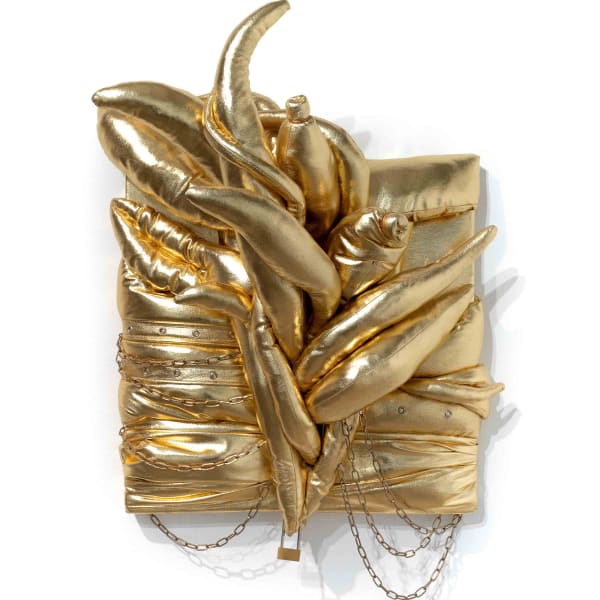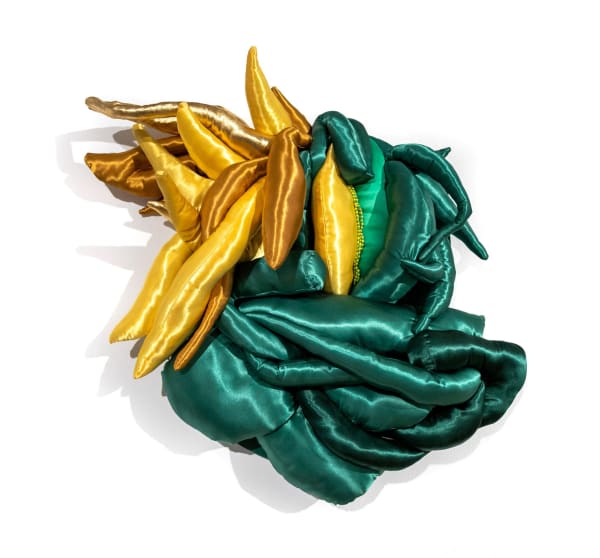Elio Rodriguez: Junglas
In his third solo exhibition at 532 Gallery, Cuban artist Elio Rodriguez returns with a new selection of his signature wall-mounted soft sculptures, including a large-scale diptych completed on the eve of the show’s installation.
Rodriguez’s works burst into the gallery space with an exuberant mashup of lush biomorphism and fashion-savvy swagger, almost like chunks of a synthetic tropical biome magically teleported from a Rousseauian fairy-tale jungle to the gallery’s white walls. While each piece is predominantly monochromatic, the range of colors and shapes seen across all of them creates an array of allusions that link his materials to the real-world phenomena that they bump up against. The new diptych (consisting of the paired works Black Forest and White Forest, both 2022) is the most direct in its implications, juxtaposing two similar clusters of puffy stuffed leaves, branches, and fruits, one in a range of brown tones similar to the artist’s own skin, and the other a pinkish caricature of a generic “white” skin tone. The earthy red in Jungla Desnuda and sootlike black in Jungla Negra (both 2021) hint at soil and ashes—gestation and death—while a more fanciful notion of life is suggested by the the sprawling Forest on the Wall (2013), an unruly white mass of bulbous trunks and flaps that seems to sprout organically from the cold, sterile surface of one long wall, like spirit demanding its release from the prison of matter. The luminous metallic Goldie (2020) highlights the way that art has always existed as a kind of false secondary nature, as well as the way we’ve plundered the earth for its riches since our earliest days. A related contrast of shapes and forms points at the tension between nature’s freedom and humanity’s will to dominate; while the aforementioned Forest seems to run rampant wherever it will, many of the other pieces hew more closely to the square or the rectangle that for centuries have so rigorously yet arbitrarily reinforced the idea of art as something fundamentally apart from (and theoretically better than) life.
Though fashioned in three dimensions with nontraditional, factory-made materials including upholstery fabrics, buckles, and chains, Rodriguez’s pieces contain the same sense of primordial mystery and irrepressible vitality seen in the dense jungle paintings of his earlier compatriot Wifredo Lam, whose work he directly references in Jungla Desnuda, which is both an homage to and a reimagining of Lam’s famous 1943 Afro-Cuban masterpiece The Jungle.
Hung in the midst of all of the soft sculptures, a large acrylic-on-canvas painting titled Jungla Oscura (2021) forces his abundant vegetal imagery into a dark and densely packed visionary space that also features glimpses of out-of-place elements like hands, strings of beads, and a 1950s vintage car that seems too large to be a toy, but too small to be the real thing. The presentation and medium are different from the other works, but the implications are the same.
Rodriguez’s abiding interest in working in ambivalent conceptual spaces—teetering between the natural and the artificial, the familiar and the unknown, the obvious and the hidden—grants his sculptures a palpable aura of whimsy and wonder without ever veering too far into the uncanny. Though they can also be seen as alluding to pressing contemporary issues like colonialism, industrial sprawl, and our relentless despoiling of nature, in the end they always return to a quasi-magical state that reminds us of the power and mystery of nature while highlighting our tragic inability to ever truly and wholeheartedly return to its embrace.
Elio Rodriguez was born in 1966, and lives and works in Spain. His practice is engaged with the system of judgments about a person, a culture, or a phenomenon. Tapping the prism of Caribbean popular culture, its underlying humor, and clichés formed about the culture, he builds witty and sensual works that seemingly incarnate that reality, and subtly and continuously question it. His practice encompasses painting, installations, sculptures, prints, ceramics, and soft sculpture interacting with chosen objects.












